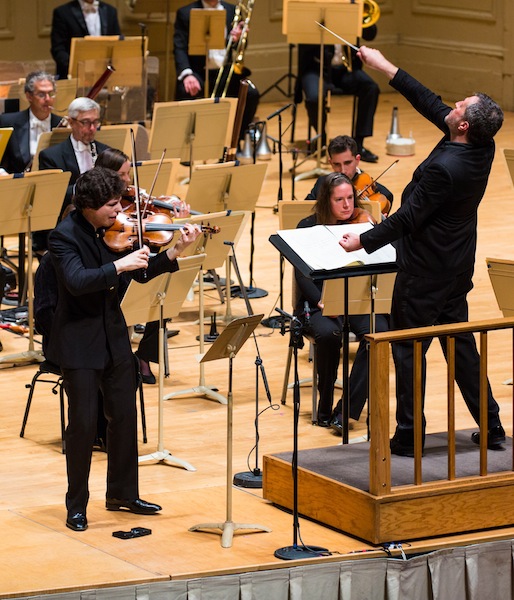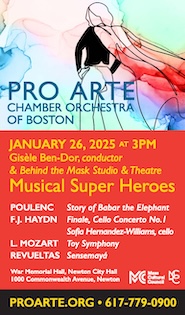Hadelich and Adès deliver supreme advocacy for Ligeti rarity with BSO

Augustin Hadelich performed Ligeti’s Violin Concerto with Thomas Adès and the Boston Symphony Orchestra Thursday night. Photo: Robert Torres
It’s not hyperbole to say that György Ligeti’s Violin Concerto is a one-of-a-kind work.
The Hungarian master took a catholic view of the genre and his masterpiece for the instrument, written between 1990 and 1993, is, appropriately, singular. Just how original the piece is – yet also emotionally direct – is one of the big takeaways from Thursday night’s Boston Symphony Orchestra concert led by Thomas Adès, where the Concerto was presented for just the second time by the BSO since 1997.
Cast in five movements, the Ligeti Violin Concerto attempts to embrace nearly the whole of Western musical history going back to about the 14th century. Archaic forms, allusions to folk music, ferocious virtuosity – this work has it all, and then some.
Its first movement, which morphs from a thin mist into a dense fog of string textures over its opening bars, is undergirded by echoes of jazz. The lyrical second movement draws on medieval compositional devices; midway through, a plangent chorus of ocarinas intrudes on the proceedings. The third movement is largely gestural: a fragmented violin melody is swallowed up by a cascading orchestral figure, dissolving into an aural waterfall. Similar descending themes mark the devastating fourth-movement passacaglia, which climaxes in a primal scream. The finale alternates brutal and relaxed figures, before a big cadenza culminates a final cadence that simply disintegrates as it proceeds.
This weekend’s soloist is Augustin Hadelich. A brilliant violinist with unimpeachable technique and beautiful tone, Hadelich, on Thursday, played the solo part with fire and style. His command of the music’s colossal technical demands was complete and his identification with the part’s searing expressive qualities total.
Hadelich was profoundly impressive in the concerto’s cadenza–written by the evening’s conductor and artistic advisor, Thomas Adès–which deftly weaves in elements of the concerto and the 19th-century virtuoso tradition Ligeti so gleefully pillaged in the piece. Adès led the BSO in an accompaniment that was fully equal to Hadelich’s solo performance, at times beautiful and terrifying; above all, it was thoroughly engrossing.
Folllowing an extended ovation, Hadelich returned for an apt encore of Paganini’s Caprice No. 21.
Equally absorbing (and not at all macabre) was the lithe, invigorating reading of Beethoven’s Symphony no. 8 that prefaced the Ligeti. In Adès’s hands, the Symphony’s Classical features – the clean lines, clearly-defined textures, sharply-etched rhythms, etc. – leapt out with bracing energy. The result was a performance of exhilarating rhythmic drive.
The bounding first movement was taut and athletic, and the metronome-inspired second droll and witty. The robust minuet theme was played with Schumann-esque fervor, while the horn and clarinet lines of the trio were liquid gold. The performance was rounded off with a blazing account of the vigorous finale, the exaggerated contrasts spotlighted by Adès and the BSO players.
After intermission came two equally substantial pieces.
The first involved the local premiere of the expanded edition of Adès’ Suite from his 1995 opera Powder Her Face. Based on the salacious life of Margaret Campbell, the Duchess of Argyll, Powder Her Face traffics in a host of styles, high-brow and low-, from jazz and tangos to “thefts” from Stravinsky, Berg, Weill, and others. The main benefit of this new Suite, which expands the three movements of the original to eight, is that it provides a welcome reminder of the sheer, manic invention found in Adès’s original score.
Otherwise, the piece offers too much of a good thing. Its necessarily fragmentary nature robs it of the internal logic that Adès large-scale concertante scores usually boast. And, in its stoutest moments, the sprawling forces cause one to miss the emotional directness and intimacy of the opera itself, with its small cast and chamber ensemble of just fifteen players.
Still, it’s a treat to hear the full BSO have at Adès’ sometimes-ribald music. The Gershwin-esque “Scene with Song” brought out delicate solos from violinist Tamara Smirnova and principal clarinet William Hudgins. Ominous, falling phrases, and snarling, muted brass marked the menacing “Wedding March.” The penultimate “Aria” was bittersweet and the “Finale” perfectly cheeky.
Stravinsky’s Divertimento from The Fairy’s Kiss, a 1928 homage to Tchaikovsky based on a series of the older composer’s early songs and keyboard works, rounded out the evening.
Thursday’s reading – the BSO’s first since 1976 – glowed. The introductory section of the “Sinfonia” sang with grace and elegance, its brisk second part rhythmically tight and colorful. The several contrasting “Danses suisses” brimmed with pert energy, and the “Scherzo” overflowed with playfulness.
The solos of the closing “Pas de deux” proved more mixed – acting principal cellist Sato Knudsen seemed to be having an off night, though principal harp Jessica Zhou and clarinetist Hudgins were in prime form. But the whole of the finale was filled with warmth and brio.
The program will be repeated 1:30 p.m. Friday and 8 p.m. Saturday at Symphony Hall. bso.org; 888-266-1200
Posted in Performances



